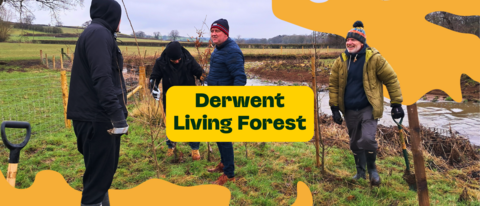
The Derwent Living Forest is an ambitious nature restoration programme across the Derbyshire Derwent catchment. The Derwent Living Forest will not only provide an extensive haven of quality habitat for wildlife but will also offer further ecosystem services such as natural flood management benefits and increased carbon sequestration to assist in adapting to and reducing the impacts of climate change
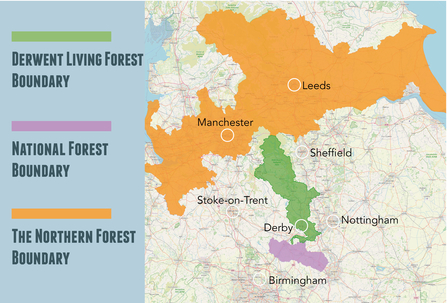
The Vision
To create 30,000 hectares of wooded habitats (such as woodland, hedgerows, orchards and parklands) and wetland by 2050 and establish a connection between the new woodlands of the National Forest in the south and the soon to be established woodlands of Northern Forest in the north. North-south connectivity, which this project will provide, is critically important to allow movement of species in response to climate change.
Working with local land-owners and community groups, the programme will make more space for nature, through improving woodland ecosystem connectivity; and make more space for water by implementing natural flood management measures and slowing the flow across surfaces and down slopes. The impacts of drought can also be reduced through natural flood management. Ponds and wetlands store water and provide a buffer against drought conditions by gradually releasing water during dry periods. The project will also work to make more space and opportunities for the public to access, enjoy and engage with these spaces!
Derwent Living Forest (https://www.youtube.com/watch?v=zewChldfSFc)
Hear from George Jones as he describes the Derwent Living Forest project.
Sign up to our monthly Derwent Living Forest Newsletter
Each month we send an email newsletter highlighting everything that is happening in our Derwent Living Forest programme from community updates to local landowner events. Sign up below and keep up to date.
Your details will not be shared with anyone else and you can unsubscribe at any time.
Derwent Connections Project
Derwent Connections was an 18-month project funded by the Green Challenge Recovery Fund which was completed by the Trust in March 2023 as part of the Derwent Living Forest Programme vision to create 30,000 hectares of wooded habitats (such as woodland, hedgerows, orchards and parklands) and wetland by 2050.
Its aim was to identify ways to make more space for nature, through improving woodland ecosystem connectivity; and more space for water by implementing natural flood management measures and slowing the flow across surfaces and down slopes.
Derwent Connections kick-started the creation of a new landscape centred around the River Derwent catchment.
Creating a landscape dynamic enough to support a rich and diverse range of habitats from which species can spread; a landscape complex enough to deliver a range of crucial ecosystem services, from carbon sequestration to natural flood management; and a landscape durable enough to withstand the untold impacts of climate change.
Working with local land-owners and community groups, the project in the last year has made more space for nature, through improving woodland ecosystem connectivity; and more space for water by implementing natural flood management measures and slowing the flow across surfaces and down slopes. The project has also worked to make more space and opportunities for the public to access, enjoy and engage with these spaces.
Derwent Connections Project Vision (https://www.youtube.com/watch?v=SCNPrOv2cus)
Aims and Objectives of the Derwent Connections Project
Derwent Catchment Map
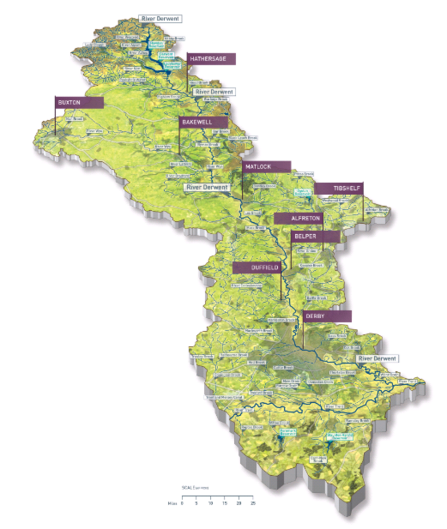
Nature Returns
Derbyshire Wildlife Trust’s vision for a Derwent Living Forest providing space for nature’s recovery and natural flood management is another step closer following the success of both the Trust’s Derwent Connections Project and the Nature Based Solutions for Climate Change Project.
The important Living Derwent Forest programme development work carried out by the team behind Derwent Connections to map out these opportunities is being delivered on the ground, with many more hectares of habitat being created.
The Living Derwent Forest programme is part of the Nature Returns programme which is led by Natural England, in partnership with the Environment Agency, Forestry Commission and Royal Botanic Gardens Kew, Wakehurst. The programme is co-sponsored by Defra and the Department for Energy Security and Net Zero (DESNZ) and is funded through the HM Treasury’s Shared Outcomes Fund.
Last year, Derbyshire Wildlife Trust was awarded funding to carry out this work which aims to create connected wooded habitats between the Northern and National Forests to allow movement of species in response to climate change.
It is part of a trial to find the most effective ways to capture carbon and mitigate the impacts of climate change. It will also develop an economically viable programme to support landowners to create and expand dynamic and resilient ecosystems.
Read the latest Nature Returns Blogs & News:

Learn more about the work in the Derwent Catchment
In this episode The Owl Hoot talks with George Jones and Ady Cox regarding Our Derwent
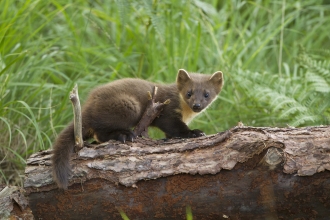
Derbyshire’s Missing Pine Marten
In this blog, Ruth Pilbeam, Programme Manager, tells us more about the vital work underway to prepare Derbyshire for the return of the…
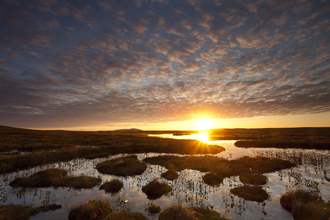
Mapping Derbyshire’s Peatlands: Nature’s Climate Solution
Our peatlands might look like soggy moorland, but they’re incredible carbon storage systems – locking away greenhouse gases and…
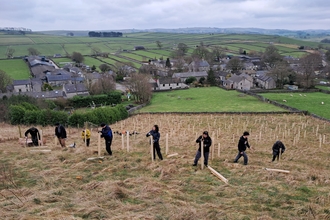
Rooted in Community: Growing the Derwent Living Forest Together
The Derwent Living Forest is one of Derbyshire Wildlife Trust’s most ambitious landscape recovery programmes but none of this is…
